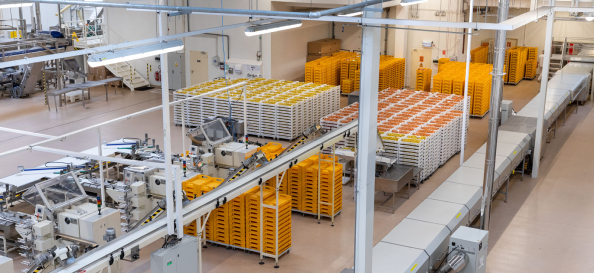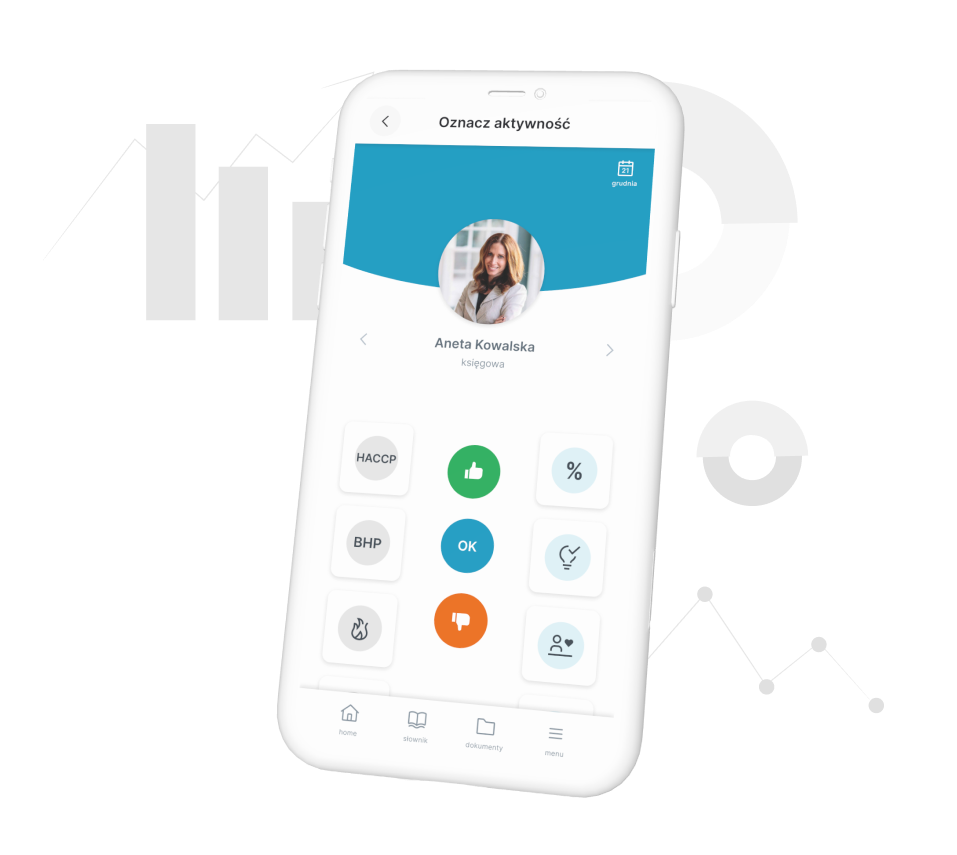Darmowy webinar!
Od frustracji do zaangażowania: jak premiować mądrze, by zwiększyć efektywność organizacji?
- Rozwiązania
- O nas
- Moduły
- Wiedza
Szkolenia
- Kontakt
Darmowy webinar!
Od frustracji do zaangażowania: jak premiować mądrze, by zwiększyć efektywność organizacji?
A case study of the implementation of WinWinBalance at Wawel

Managing a multi-generational organization with its own traditions – especially in a situation of
unexpected turbulence and changes in the labor market – isn’t a piece of cake. This was experienced
firsthand by Wawel, one of the oldest producers of sweets in Poland. Driven by a desire to introduce
greater transparency in its approach to bonuses and rewards and to improve the flow of
information about what’s occurring in the organization, the company decided to implement an application
for the ongoing registration of employees’ effectiveness and commitment.
Wawel’s production plant employs workers of all generations, from Baby Boomers and Millennials to Generation Z-ers. Such great diversity creates challenges for building engagement, as it’s known that what is an effective tool for motivating workers of age 50+ doesn’t necessarily work for a group of persons in their 20s.
Wawel is one of the oldest confectionery factories in Poland, boasting traditions dating back to the end of the 19th century. Currently, it employs almost a thousand employees, including over 600 in the production facility in Dobczyce, near Kraków.
We have vast experience in the production of sweets – in this year we celebrate our 125th
anniversary. That’s a reason for us to be proud. Nevertheless, due to the fact that our
method of managing production employees – unchanged for years – had simply become
outdated, we made the decision to strengthen our employee bonus system.

Joanna Sztefko
Director of Administration at Wawel.




Like many production plants, wawel had employee assessment tools; however, these covered selected levels of office workers, salespersons, and managers. Line workers in production were excluded from this assessment; for them, there were no mechanisms or individual motivational tools, apart from a bonus granted on a discretionary basis to each team member, without explicit reference to his or her involvement in the profits generated (with the only exception being negative and undesirable events that resulted in withholding of the bonus payment).
The company’s attention came to focus on the WinWinBalance application, which enables daily registration of actual events and facilitates the formulation of fairer and more constructive feedback. A manager gives a worker points for his or her activity, which can be either a simple “OK” for working in accordance with the standard, a “plus” for outstanding positive behavior, or a “minus” (corrective feedback) with an indication of what should be improved. Thanks to this, an employee continually receives reinforcement that’s positive or corrective (if something needs improvement).
The application attracted Wawel’s interest primarily because it provides the opportunity to treat each employee individually. Introduction of the program began with a three-month pilot in a production department employing approximately 300 people. It quickly became clear that Wawel needed more than the application’s standard version, with which a manager assesses work efficiency at his or her discretion, without the use of objective external data — e.g., indicating whether an employee worked at, above, or below 100%. Wawel recognized that it was worth combining the application with direct productivity metrics: such an application module — prepared especially for the company’s needs — makes it possible directly link a worker with the orders on which he or she worked and with the efficiency of their execution. In this way, the company gained more measurable data, on the basis of which it could build a policy for employee compensation and motivation.
Using our application is simple. However, it’s important to refer to facts in the information, to name what was good or bad in the employee’s behavior, what was appreciated and what resulted from these behaviors for the team and the company.

Michał Eryk Południok
CEO WinWinBalance
The company decided to implement the WinWinBalance application in all production departments after a pilot program. The solution provider began the project by conducting workshops on providing constructive feedback. As Michał Eryk Południok notes, production managers are typically individuals who are promoted from line positions and often lack preparation for managerial roles. They have difficulties with giving praise, do not know how to use corrective feedback to encourage, rather than discourage employees to perform tasks.
"For managers in corporations, what is often standard practice can be new for leaders in manufacturing plants, which is why conducting workshops was so important for the success of the project," says the CEO of Brad Consulting.
With this application, we can measure two important aspects for us: on one hand, engagement, meaning all of the employee’s positively outstanding behaviors, and on the other, their efficiency. Analyzing the data from the application gives us answers to the important questions we have, such as how engagement affects efficiency.

Joanna Sztefko
Director of Administration at Wawel.
During the workshop, it was possible to develop engagement criteria – a shared scope of desirable and undesirable behaviors for the organization, which was entered into the application. The competencies of communication, cooperation, and responsibility for the work performed were described in a language understandable to all, coming from the organization’s culture and experience. As a result, providing feedback and points for engagement has been standardized and independent of subjective recognition by superiors. Now, outstanding behaviors in all production teams are recorded in the same way.
"Of course, they can and will be subject to periodic review and updates, as after the initial period of using the system, we are already richer in authentic experiences of supervisors - emphasizes Joanna Sztefko."
According to Michał Eryk Południok, the standards of using the application are a kind of three-party social agreement. Firstly, with the employees that if they behave in the manner indicated in the set of desired competencies, it will be noticed and credited to their account. Secondly, it is an agreement with the masters that they will systematically record outstanding behavior of the employees, adhering to the jointly defined and understood standard. This provides them with a tool for motivating employees. The third party to the agreement is the company, which commits to the fact that the most outstanding employees will be appreciated and rewarded in a specific way.
As emphasized by Joanna Sztefko, the company has devoted a lot of time to train functional staff using the application as managers, in order to familiarize them with the idea and principles of ongoing feedback. The company wanted noting outstanding employee behaviors in the application to be systematic, as only then it makes sense. Every supervisor must remember to note how specific orders have been fulfilled after they are closed, giving positive points to those who stand out – and negative points to those who do not. Of course, if there was no reason to stand out or point out mistakes, the supervisor assigns a simple “ok” – usually employees perform their duties correctly. Importantly, praise or corrective information cannot be given solely digitally and cannot replace a conversation with the employee. Before they reach the application, the supervisor should communicate it directly to the interested party.
The system also does not allow for collective “ok” for all employees. This limits the supervisor who, when closing an order, must take two or three seconds to think about each employee’s work before entering “ok” in the system. Employees can also ask their supervisor or manager for access to their account on the application to verify the points awarded. The company wants to offer production employees access using an individual password and login in the future. This is already available to office employees on the company network, who are also covered by the system.
Currently, 99% of organizations are covered by the system. We do not call it a work assessment, but rather a recording of daily events. There is one system, with the same rules applying to everyone, although competencies vary slightly depending on the role - subject to recognition and point assignment. Experts record events that happen to employees, managers to experts, and directors to managers. There is full cascading and transparency, thanks to which we have a better understanding of the organization's life, and we can manage the data as we please - says Joanna Sztefko.
Joanna Sztefko was asked about the positives resulting from the implementation of the system. She identified the certainty that, thanks to the data from the application, bonuses are being distributed in a fairer and more objective way as the top benefit. The company incorporated this data into the existing bonus system for production departments, which resulted in what had previously functioned on the basis of subjective evaluation by superiors gaining solid data on the behaviors and effectiveness of individual employees. Based on this, a specific bonus indicator is calculated for production workers and proposed to the supervisor, who still has the final say in the bonus process.
"Thanks to linking specific employees with indicators of production efficiency, we have developed more reliable algorithms that allow us to provide bonuses in a fair manner, dependent on the true commitment and performance of the employees," states Joanna Sztefko.
The arguments presented are also a factor in periodic decisions regarding salary increases and promotions. Another positive aspect resulting from the implementation of the WinWinBalance system is more efficient talent management within the company. With comprehensive information on employee behavior, it is much easier to identify those who demonstrate above-average commitment and plan their career path in advance. This also applies to various initiatives and improvements – by recording them in the system, it is easier to identify employees who stand out for their creativity and resourcefulness. Another benefit, perhaps not directly resulting from the system, but certainly a consequence of it, is the attention brought by supervisors to the feedback process.

In companies like Wawel, which come from the industry and have over 100 years of history, a culture of continuous feedback is not always obvious. Many of our employees, especially from the older generation, have never encountered it before and do not consider it necessary. However, the younger generation craves it. Therefore, for the masters, who often come from the baby boomer or X generation, introducing a tool for daily monitoring of engagement and effectiveness was a revolution. We hope that the application helped them understand how important positive feedback is given on this occasion and also made them feel that systematic recording of outstanding behaviors in the team is a concrete tool for building team engagement and achieving goals – notes Joanna Sztefko.
"Wawel is already considering expanding the application with additional modules. The system provides the ability to obtain data necessary for predicting unwanted events, hazards, and violations of health and safety regulations, which is extremely important for a food producer subject to strict restrictions."
The solution provider addresses concerns that may arise among employees involved in the system production. Michał Eryk Południok emphasizes that the tool gives employees freedom of choice, does not force them to compete, and is not “judgmental” in a negative sense. When a company begins implementing the application, a clear message should simultaneously be conveyed to employees that if an employee is not exceptionally committed and performs their duties correctly, this is a satisfactory attitude for the employer.
"He receives assurance that if his commitment stands out and he puts more effort into his work, the company will reward him above standard."
Similarly, in a situation where the work is below standards, their potential bonus will also be lower. It is up to the employee to make the decision,” emphasizes Michał Eryk Południok.
The implementation of the system in its standard version, as observed by Wawel in the pilot phase, went relatively quickly. However, the decision to expand the production module significantly prolonged the work due to programming and stabilization of the system with new features. Whenever a decision is made between standard and modification, it is important to consider not only the time but also the intensive work of the supporting departments in the organization, in our case the HR and IT departments. The WinWinBalance team responded flexibly to our needs, but the complexity of the process and the level of engagement on our company’s side increased significantly. Another important factor to always remember when implementing any system related to performance evaluation or work registration is that the expectations of office workers, higher-level supervisors, or management will always differ from those of production employees.
This simply stems from the fact that working in these two environments is extremely different, which affects the perception of proposed solutions and their potential uses. While line workers evaluate the system from a “here and now” perspective, specialized departments and management expect good reports, summaries, and guidance on people management – emphasizes Joanna Sztefko.
Therefore, during implementation, it is important to consider these two completely different sets of expectations.
If we focus on meeting the needs of one group, there is a risk that the other group will not receive answers to their needs as quickly and well as they expected. In such a large organization, this is a constant challenge. That’s why we are currently conducting an internal evaluation of the system to maximize its potential – summarizes Joanna Sztefko.
Wawel is a large and stable employer who, like other manufacturing plants, faces challenges in people management. This is partly due to the difficult past two years. The company is working to reduce turnover and maintain employment levels in production. As the production plant is located in Krakow, the employer has launched additional corporate bus connections to make it easy for employees to commute to the factory. Wawel aims to compete with good working conditions and transparent pay, and therefore has decided to implement an application that enables fairer bonus payment.
“The crisis and difficult market situation have forced us to take actions that were not necessary before. Today, we see how much has been changed in the company and we hope that this is not the end,” summarizes Joanna Sztefko.”

Joanna Sztefko
Director of Administration at Wawel.
Text author: Anna Włudarczyk.
The article originally appeared as a case study in the “Personnel and Management” monthly magazine, issue 1/2023, under the title “Rewarding based on sound basis: Continuous feedback in the Wawel company.” Reprinting with the author’s permission.

© 2023 WinWinBalance. All rights reserved.